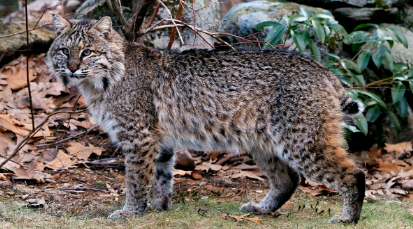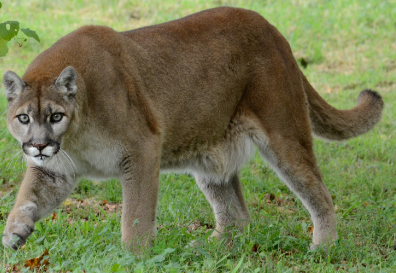Bobcat
The bobcat is a medium-sized wildcat, measuring about double the size of domestic cat. It is found in a variety of habitats across the southern half of North America. They are widespread and adaptable predators that are closely related to the larger and more northerly dwelling Canadian Lynx.
There are currently twelve recognized sub-species of Bob-cat which vary in their coloration and geographic range, with those found in mountainous forests being darker with more markings than their lighter-colored counterparts found in more arid, semi-arid or semi-desert environments.

What You Need To Know About Bobcat
- Scientific name of bobcat is Lynx rufus.
- The majority of the world’s bobcats are found in the United States but they range from Mexico to southern Canada.
- Bobcats are sometimes referred to as wildcats; they are roughly twice as big as the average housecat.
- The bobcat is adaptable animal and it can live in a wide variety of habitats. It prefers woodland environments or boreal coniferous and mixed forests. It also creates habitats near agricultural areas, rock ledges, swamps or forested tracts.
- Have whiskered face due to ruffs of extended hair beneath the ears.
- Bobcat has a sharp hearing and vision and a good sense of smell.
- It has a tawny to brown-colored coat which can appear gray or almost black, depending on light conditions.
- Bobcats communicate through scent, visual signals and vocalizations. Scent marking happens by urinating along travel routes, depositing feces in latrine sites and scraping urine or feces along the trail.
- The nose of the bobcat is pinkish-red and it has a base color of gray or yellowish or brownish-red on its face, sides and back.
- They have long legs with large paws
- Bobcats have tufted ears, where hair sticks up from the top of the ear.
- It is smaller with a body length of about 2-4 feet
- It weigh between 11 to 35 pounds
- Bobcats have a short black-tipped chubby tail. The tail is usually between 3 and 5 inches long.
- Bobcats are carnivorous; they eat smaller creatures like rabbits, rodents and mice. They also hunt small deer, snakes, lizards and domestic animals such as dogs, cats, sheep, goat and poultry.
- Bobcats average lifespan in the wild ranges between 5 to 10 years.
- The bobcat may have external parasites, mostly ticks and fleas and often carries the parasites of its prey, especially those of rabbits and squirrels.
- Bobcats can run at up to 30 miles per hour and they put their back feet in the same spots where their front feet stepped to reduce noise when hunting.
- Bobcat is an excellent climber and can leap high enough to catch low-flying birds.
- The population of bobcat depends primarily on the population of its prey and other factors such as type of habitat, dense cover for hiding, den sites and freedom from disturbance.
- The mating season of the bobcats is in the winter, though mating can take place anytime from November until August.
Mountain Lion
The mountain lion is a large, tan colored cat species native to North America, Central America and South America. In United States these cats live primarily in western states and Florida. Also referred to as cougar, puma, catamount and panther, mountain lions thrive in many habitats. They live in more geographies than any other western hemisphere mammal, besides humans.

What You Need To Know About Mountain Lion
- Scientific name of the mountain lion is Puma concolor.
- Mountain lions are also referred to as cougars, pumas, panthers, painters or catamounts.
- Mountain lions are generally found in remote mountains, wetlands, canyonlands or hilly areas with good cover.
- They have a slender and agile body with a round head
- It has an orange-brown to yellow-brown coat.
- Mountain lion has rounded erected ears.
- It are relatively large with a body length of between 4 and 6 feet
- It are heavy, weighing between 70 to 187 pounds
- It has a long and cylindrical tail with a dark tip. The tail is usually between 25 and 35 inches long.
- Mountain lion are carnivorous and mainly eats deer. They also eat other animals such as the coyotes, porcupines, raccoons, jackrabbits and squirrels.
- Mountain lion have large paws and proportionally the large hind legs allowing for their great leaping and short-sprint ability.
- Mountain lion average lifespan in the wild is between 8 and 13 years. Those in zoos can live to 20 years or more.
- Female mountain lions only produce once every two or three years. The gestation period is approximately three months and females take the sole responsibility of rearing the young. The young may stay with their mother for as long as 24 month, but usually separate after about 16 months.
- It is excellent in climbing, which allows it to evade canine competitors.
- Unlike other large cats, mountain lion cannot roar. Instead they growl, shriek, hiss and purr, similar to house cats.
- Early mornings and evenings are the preferred hunting times for mountain lion and they usually use the strategy of ambushing their prey.
Difference Between Bobcat And Mountain Lion In Tabular Form
| BASIS OF COMPARISON | BOBCAT | MOUNTAIN LION |
| Kingdom | Animalia | Animalia |
| Phylum | Chordata | Chordata |
| Class | Mammalia | Mammalia |
| Order | Carnivora | Carnivora |
| Family | Felidae | Felidae |
| Genus | Lynx | Puma |
| Scientific Name | Lynx rufus | Puma Concolor |
| Common Name | Bobcat | Mountain Lion |
| Other Names | Red Lynx, Wildcat | cougars, pumas, panthers, painters or catamounts. |
| Group | Mammal | Mammal |
| Number of Species | 12 | – |
| Location | North America | Mexico, South America, Central America And North America |
| Habitat | Mountainous Forests, Swamp, Desert | Forest And Mountainous Regions |
| Color | Tawny, Beige, Brown, Red, Black, White. | Tan, Black or Brown |
| Skin Type | Fur | Fur |
| Size | 65cm-100cm (25in-40in) | 4-6 ft |
| Weight | 4.1 kg-15.3kg | 64-198 lbs |
| Top Speed | 55kph (34 mph) | 45km/hr (30mph) |
| Diet | Carnivore | Carnivore |
| Prey | Rabbits, Mice, Deer | Deer, coyotes, porcupines, raccoons, jackrabbits and squirrels. |
| Predators | Cougar, Wolves and Cayotes | Human, Grizzly Bear |
| Lifestyle | Nocturnal/Crepuscular | – |
| Group Behavior | Solitary | Solitary |
| Lifespan | 12-15 years | 8-13 years |
| Age of Sexual Maturity | 1-2 years | 2-4 |
| Gestation Period | Approximately 70 days | Approximately 90 days |
| Average litter size | 3 | 2-3 |
| Name of Young | Kitten | puma |
| Age of Weaning | 12 | 10 |
| Conservation Status | Least Concern | Least concern |
| Estimated Population Size | 1.2 Million | 800000 |
| Biggest Threat | Hunting and habitat loss | Hunting and habitat loss |
| Most Distinctive Feature | Short ear tufts and bobbed tail. | Powerful forearms and paws and muscular jaw |
Comments are closed.